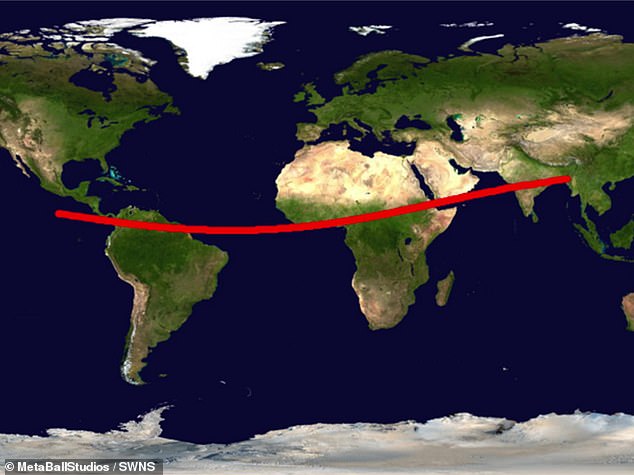The terrifying prediction that a ‘city-destroying’ asteroid is hurtling towards Earth has set alarm bells ringing at the world’s space agencies.
Now, a NASA scientist has predicted exactly where the asteroid 2024 YR4 could strike.
David Rankin, an engineer with the NASA-funded Catalina Sky Survey Project, has sketched the ‘risk corridor’ according to the asteroid’s current trajectory.
If 2024 YR4 really does hit Earth in 2032, it should fall somewhere in a narrow band stretching from northern South America across the Pacific to sub-Saharan Africa and into Asia.
Worryingly, this path extends over several densely populated regions including Chennai, India and Hainan Island, China.
Currently, NASA estimates that the asteroid has a one in 48, or 2.1 per cent, chance of colliding with the planet on December 22, 2032.
And with a diameter of up to 90 metres (300ft), or roughly the size of the Statue of Liberty, it could cause devastating damage to any populated area along the risk corridor.
If it were to strike, experts suggest it could unleash a blast equal to eight megatons of TNT – more than 500 times the size of the atomic bomb dropped on Hiroshima.

Scientists have predicted the exact path (shown in red) where the city-destroying asteroid 2024 YR4 could hit Earth. It should fall somewhere in a narrow band stretching from northern South America across the Pacific to sub-Saharan Africa and into Asia
2024 YR4 was first detected in December last year but has quickly shot to the top of NASA’s and the European Space Agency’s (ESA) impact risk tables.
The asteroid is currently the only large asteroid with an impact probability greater than one per cent and has been awarded the rare rating of three on the Torino Scale, a scale for measuring the danger posed by asteroids.
The ‘God of Chaos’ asteroid 99942 Apophis is the only other object in the history of astronomy to be given a rating of three or higher on this scale.
While the odds of 2024 YR4 hitting Earth are still slim, Dr Rankin was able to use data about its orbit to predict where it might hit.
In the scenario where the asteroid does indeed collide with Earth, the ‘risk corridor’ threatens countries including India, Pakistan, Bangladesh, Ethiopia, Sudan, Nigeria, Venezuela, Colombia, and Ecuador.
Where it lands will also determine just how powerful the impact is, with regions at the end of the corridor more likely to receive a glancing blow.
However, there currently isn’t enough information to say where along this risk corridor the asteroid is most likely to hit.
Dr Rankin told Space.com: ‘Size and are big players in possible damage, along with impact location.

NASA predicts that the asteroid 2024 YR4 currently has a one in 48, or 2.1 per cent, chance of hitting Earth on December 22, 2032 (stock image)
‘It’s hard to constrain size and composition with the current orbital situation, as it’s outbound. Typically, the best way to constrain size is with radar observations and those are not possible right now.’
It is currently estimated that the blast would be similar in size to the Tunguska asteroid which detonated in an air-burst explosion in 1908.
While this blast hit an unpopulated area, the shockwave still flattened an estimated 80 million trees over 830 square miles (2,150 square kilometres) – more than twice the land area of New York.
At the higher end of estimates, scientists suggest this explosion could have been equivalent to 15 megatons of TNT.
A blast this powerful would topple residential buildings and cause fatalities up to 12 miles (18.9 km) in any direction from the epicentre.
In the coming months, NASA and ESA hope to use Earth’s most powerful telescopes to further refine their predictions about the asteroid’s orbit.
This includes a rare emergency decision to grant an international team of scientists the use of the James Webb Space Telescope (JWST) to study 2024 YR4.
This team will use the JWST’s infrared sensors to measure the heat radiating from the asteroid to make a better prediction of its size and orbit.

With an estimated size of up to 90 metres (300 ft), or roughly the size of the Statue of Liberty, 2024 YR4 could hit Earth with a blast equal to eight megatons of TNT (artist’s impression)

Asteroid 2024 YR4 is about the same size as the Tunguska asteroid, which caused the largest impact event in recorded history when it shot through Earth’s atmosphere in 1908, flattening 830 square miles (2,150 square km) of forest (pictured)
Scientists will also have a good opportunity to learn more about the asteroid when it makes its first close pass of Earth in March at a distance of around 5 million miles (8 million kilometres).
The world’s space agencies currently predict that the impact probability will drop towards zero as they learn more, but an impact cannot currently be ruled out.
A new simulation of the asteroid’s path also presents a slim possibility that it could hit the moon instead of Earth.
Dr Rankin’s calculations suggest that there is a one in 333 chance that 2024 YR4 will collide with the lunar surface, creating a brilliant but otherwise harmless explosion that could be seen from Earth with the naked eye.
However, for the countries along this predicted risk corridor, these predictions raise the chilling possibility that they may face a devastating collision within the next eight years.
This article was originally published by a www.dailymail.co.uk . Read the Original article here. .


